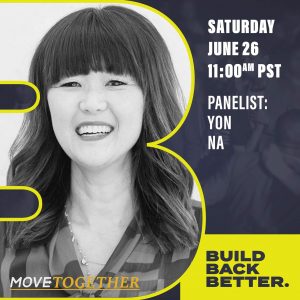“In the past year and a half, we have been confronted with some uncomfortable truths, and many of us have had to do some deep soul searching. Last summer, in response to the need of this community, Move Together hosted a panel to amplify black voices, teachers, academics, musicians, dancers and scene leaders. As we are aware, we have two viruses going on in the United States, and we only have a vaccine for one of them. We are here to take some leadership and ease in the transition back for all of us into personal spaces.” – Shaheed Qaasim
iLindy is committed to expanding our learning about the Black Community. One way we did this is by attending virtual events like Build Back Better, hosted by MoveTogether. The aim of the event was to boost Black voices from the Lindy Hop Community. We’ve summed up some of the key takeaways that made the most impact on us.
Check out Part 1
Check out Part 2
Check out Part 3
In Part 4 of Move Together – Build Back Better, the panelists discuss the importance of data driving decisions to create a more inclusive dance community, and how to get back into social dancing safely after the covid-19 pandemic. We’ll highlight some of our favorite moments shared by the brilliant Dr. Yon Na and Dr. Dorry Segev below. As these are but a few of the golden moments, we strongly recommend watching the clip for yourself. Enjoy!
Click the image below to watch it on YouTube
2:01:04 – Judith Asem PhD & Deon Harrell – Swing Diversity Directors – https://swingdiversity.com/
They present the Swing Diversity initiative. “Swing Diversity endeavors to be an agent of change and to celebrate diversity and help to include inclusion and equity in the West Coast Swing community.”
“Our three initiatives are: representation and scholarship; awareness and education; and accountability and policies.”
From accountability and policies:
“The third initiative addresses the current lack of accountability in our community. We hope to work with the events on providing audits to show where we have been and develop roadmaps to show where we’re headed. With measurable metrics to celebrate progress and assess continued areas of opportunity—as you can see we have a lot of plans—and it will take time to implement but we have one example of a early stage case study to share with you.”
 2:06:25: – Dr. Yon Na, earned her doctorate in organizational psychology. She is a DEI and organizational effectiveness consultant for Fortune 500 and high-growth companies. She founded Radiance HQ, an organization dedicated to advancing Asian women in the workplace.
2:06:25: – Dr. Yon Na, earned her doctorate in organizational psychology. She is a DEI and organizational effectiveness consultant for Fortune 500 and high-growth companies. She founded Radiance HQ, an organization dedicated to advancing Asian women in the workplace.
The topic of creating a sense of inclusion, equity, and diversity in the dance scene might seem very broad, so Dr. Yon Na shares some easy steps that you can take in order to develop this desired environment in the dance scene.
“Where do I start?”
“Start by looking at data. […] Quantitative data and qualitative data. Since we are talking about human beings, qualitative data is so important to paint a larger picture. So, think about data driving decisions. Whatever decision you make, make sure that you collect data first.”
Here are some steps suggested by her that you can take in order to start creating a better and more inclusive community:
Define your values:
“Start by what are the values of your event. […] That is the northstar for where you want to go in terms of enhancing DEI in the dance community.”
Collect data:
“Take a diversity snapshot of your demographics in terms of gender, race, ethnicity, even generational differences.”
Create an easy survey. For example, a quick poll survey related to inclusion and belonging in connection to the venue where you are holding your event.
“You don’t know what people need until you ask. … You need to collect the data to inform what the solution is going to be.”
Dr. Yon Na highlights the importance of using the right terminology when applying surveys. She recommends the Diversity Style Guide which is constantly updated to use as a reference.
Last, but not least, don’t expect to do everything correctly right away:
“You will make mistakes along the way. […] It’s important to recognize that you’ve made an offense, acknowledge it, apologize and keep moving forward and learn from that mistake.”
 2:16:09 – Dr. Dorry Segev (MD, PhD) is Professor of Surgery and Epidemiology and Associate Vice Chair of Surgery at Johns Hopkins University. He has published over 650 peer-reviewed research articles and is ranked #1 worldwide in organ transplantation expertise and influence by Expert Scape. Reflecting on his contributions to health care, he was recently elected into the National Academy of Medicine.
2:16:09 – Dr. Dorry Segev (MD, PhD) is Professor of Surgery and Epidemiology and Associate Vice Chair of Surgery at Johns Hopkins University. He has published over 650 peer-reviewed research articles and is ranked #1 worldwide in organ transplantation expertise and influence by Expert Scape. Reflecting on his contributions to health care, he was recently elected into the National Academy of Medicine.
Reflecting the creativity and broad reach of his contributions, he received a prestigious Global Thinker Award from Foreign Policy Magazine and was named an Innovators of the Year by TIME Magazine. His work has directly influenced policy, including two Congressional bills (the Norwood Act for kidney exchange and the HOPE Act forHIV-to-HIV transplants), and is regularly featured in widely read media including several front-page features in the New York Times. In the context of the pandemic, Dr. Segev has shifted his research to better understanding coronavirus and its implications in solid organ transplantation.
“I strongly feel that right now the only reasonable way for us to have a social dance event is vaccine only. Unvaccinated people put our entire community at risk. This is not a personal judgement, it’s just a medical fact.”
Here are a few reasons why Dr. Dorry Segev defends this statement:
“The vaccine is contraindicated in almost nobody.”
Most unvaccinated people either haven’t had access to the vaccine or simply don’t want to be vaccinated.
In the first case, “I think it’s totally reasonable to ask a dance community to devote energy and bandwidth to helping people get access to the vaccine”.
“But the majority of unvaccinated people […] who want and demand to attend dance events are people who have chosen not to be vaccinated. It’s fine for them to make this choice, but it is not fine for them to put an entire ballroom of people or an entire dance community at risk. It’s a free choice, but not one that should be free of consequences.”
What the CDC has to say: The CDC guidelines state that vaccinated people are safe without masks and social distancing, but unvaccinated people should stay distanced and masked.
“Unvaccinated people should not be social dancing. How can you stay six feet away from everyone, as the CDC says you should, and be social dancing?”
Dr. Segev also states that “There should be a very clear safety protocol for a dance event.” Just as there are other protocols that events must create and follow, there should be one for covid-safety.
He finishes his part by sharing one of his main concerns:
“I must say that the thing that worries me even more about an unvaccinated person wanting to attend a social dance event… I am more worried, not just that they are unvaccinated, but that they are sending this message that ‘I refused to be vaccinated, yet I still expect to interact with all of these people in a social dance event.”
Again, this is not at all-inclusive of the entire value of the discussion and we strongly recommend that you go watch it yourself.
—————————
“We at #MoveTogether are aware that many dancers have justifiable fears and concerns as the dance scene begins to reopen. We have all had safety concerns around COVID-19 in the past year, but there is a fear that the issues around diversity, equity, accessibility, and inclusion will be overlooked.
We are at an opportune moment in our dance scene. We have a chance to not just restart, but to rebuild from the ground up. A chance to change the systemic issues that plague our scene.
Move Together is partnering with the Black Lindy Hoppers Fund for the Build Back Better event!
🔸 Love what you’re hearing? Help support and Donate! https://bit.ly/3gFCFRz
Donations will go towards:
Interested in the Move Together – DEI Toolkit? Check out their resources here!”